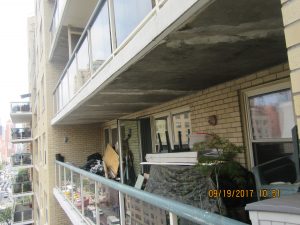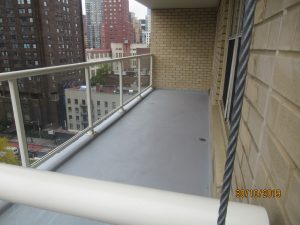
Most buildings have a life cycle of approximately 50 years. However, in order to reach 50 years and increase the service life of a building, significant improvements and restoration efforts are required along the way, from the commissioning stage through 50-year anniversaries. RDH’s article “How Long do Buildings Last?” does a great job of outlining the timeline of each stage and what to expect during the life cycle of your building.
As for balconies, building owners should be prepared to perform regular maintenance and targeted repairs during the first ten years of the building’s commissioning. Regular maintenance may include, but is not limited to, periodic cleaning and washdowns of the balcony railings and waterproofing membranes, sealant replacement at the glass panel infill railings or round-sleeved railing posts into the concrete, and waterproofing repairs. The warranty for waterproofing coatings on concrete ranges from five to ten years, depending on the system and product selected, so it is recommended that owners plan to replace the waterproofing system on their balconies within that timeframe. Periodic evaluations of the waterproofing system by a qualified engineer or architect could extend the lifespan of each system, depending on the state of its condition during the inspection.
If an owner is not proactive and consistent in maintaining a balcony’s waterproofing system, the potential for more problematic issues can develop over time. For example, the majority of cantilevered concrete slabs develop cracks over time due to shrinkage, creep, or in the worst cases, overloading. If these cracks go unnoticed for long enough, costly and urgent repairs are often required. After the balcony waterproofing system fails and cracks have developed, moisture will infiltrate the slab and eventually wreak havoc on the slab’s structural reinforcement. Prolonged moisture exposure to the steel reinforcement will cause it to corrode and delaminate from the reinforcing bar. The section loss from the corroded steel bars will eventually spall the concrete due to the increased pressures within the slab.

These issues will continue to occur over the life cycle of the balcony unless proper measures are taken. The longer that water infiltration is left unaddressed, the heavier the repairs, which is why it is important to retain an engineer or architect early on. Small issues within the waterproofing system and signs of steel corrosion, such as rust on the underside of cracks, can be repaired with partial depth repairs, whereas failed and spalled concrete may require full-scale replacement or supplemental reinforcement of the balconies. This large-scale work typically requires a concrete permit, partial shutdown of the street (which involves the Department of Transportation), a pump truck to transport concrete, significant formwork installation concrete placement, and a comprehensive design by a structural engineer. All of these steps need to be done before new waterproofing and new railings are installed after the concrete has cured. To sum it up, being proactive and performing routine maintenance is much easier and less costly than a full-scale balcony replacement!

As long as balconies are properly maintained, residents and building owners should expect only minor issues, such as ponding water. Since balconies are outside structures, leaves and miscellaneous debris can clog the drain, so make sure to keep the drains clean and free of potential clogging hazards. Carpets, rugs, and other decorations should be lifted, and the balcony surface cleaned of any potentially trapped water. If water from rain or watering plants does not evaporate from the balcony after 48 hours, a broom should be used to direct the water towards the drain. Although this may sound inconvenient, the weight of standing water can severely compromise the balcony’s structural integrity, and eventually lead to the need for a balcony replacement.
We urge building owners to account for the upkeep of their balconies, along with other building elements, throughout the entire life cycle. If budgeting is considered during the commissioning of the building, these capital improvements will be less costly or problematic in the future. No one wants to be scrambling to find the funds for a restoration project during a 50th anniversary, so be proactive with maintenance as balconies and buildings age.